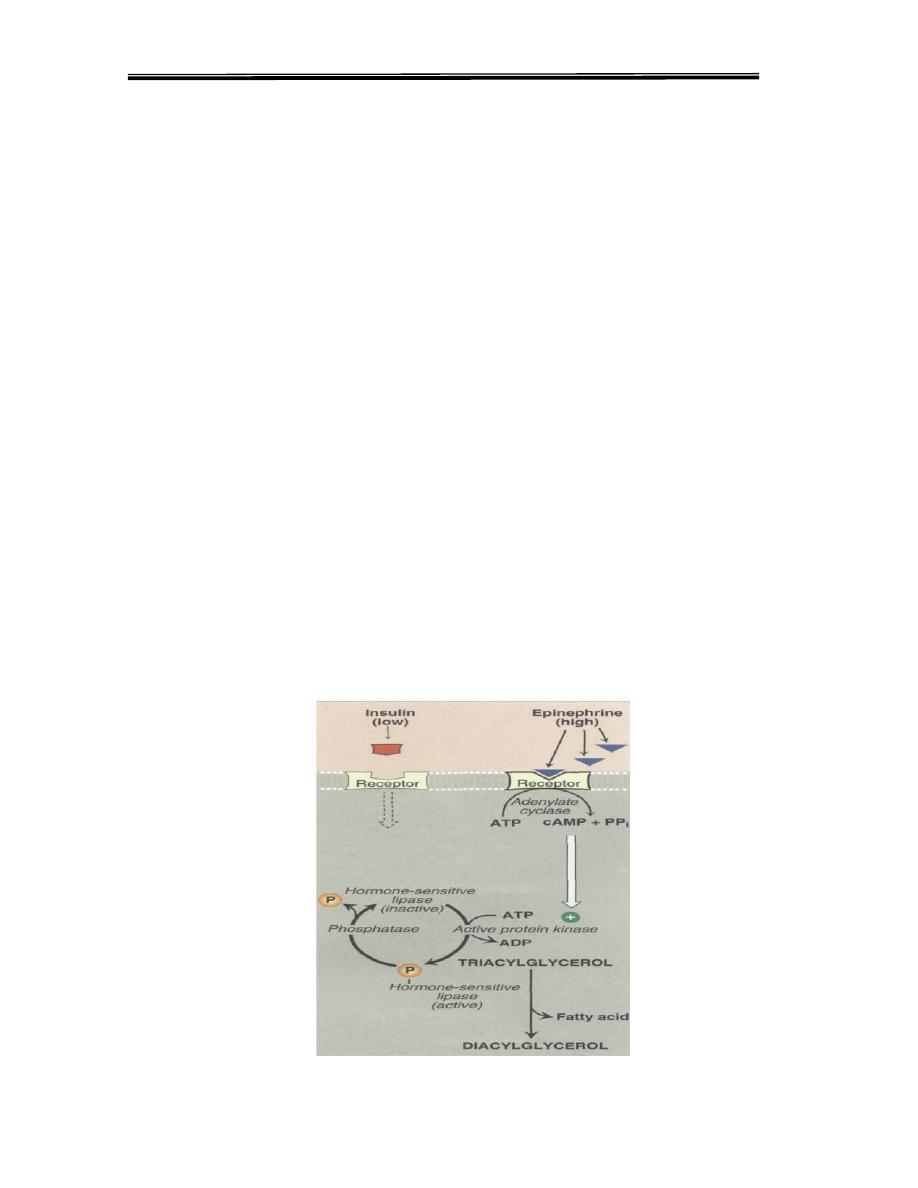
Clinical biochemistry second stage
1
OXIDATION OF FATTY ACIDS (LIPOLYSIS)
Fatty acids stored in adipose tissue, in form of neutral TAG, serve as the
body's major fuel storage.
The main oxidations of fatty acid are:
α - Oxidation
Β- Oxidation
ω- Oxidation
Quantitatively β oxidation of fatty acids is the most important pathway
which occurs in the mitochondria. However α and ω also occur,β-
oxidation of fatty is the most important pathway for fatty acid oxidation.
The initial event in the utilization of fat as an energy source is the
hydrolysis of triacylglycerol .This process is initiated by hormone-
sensitive lipase (HSL), which removes a fatty acid from carbon 1 and/or
carbon 3 of the TAG. Epinephrine (as well as norepinephrine) and
glucagon stimulate fatty acid release from triglycerides stored in
adipocyte fat droplets, whereas insulin action is to counter the responses
to these two hormones, and conversely, to induce fat storage. Epinephrine
and glucagon binding to their respective receptors triggers activation of
adenylate cylcase which lead to activation of HSL, this enzyme is
'activated when phosphorylated by 3',5'-cydie AMP-dependent protein
kinase while in the presence of high plasma levels of insulin, HSL is
dephosphorylated, and becomes inactive.
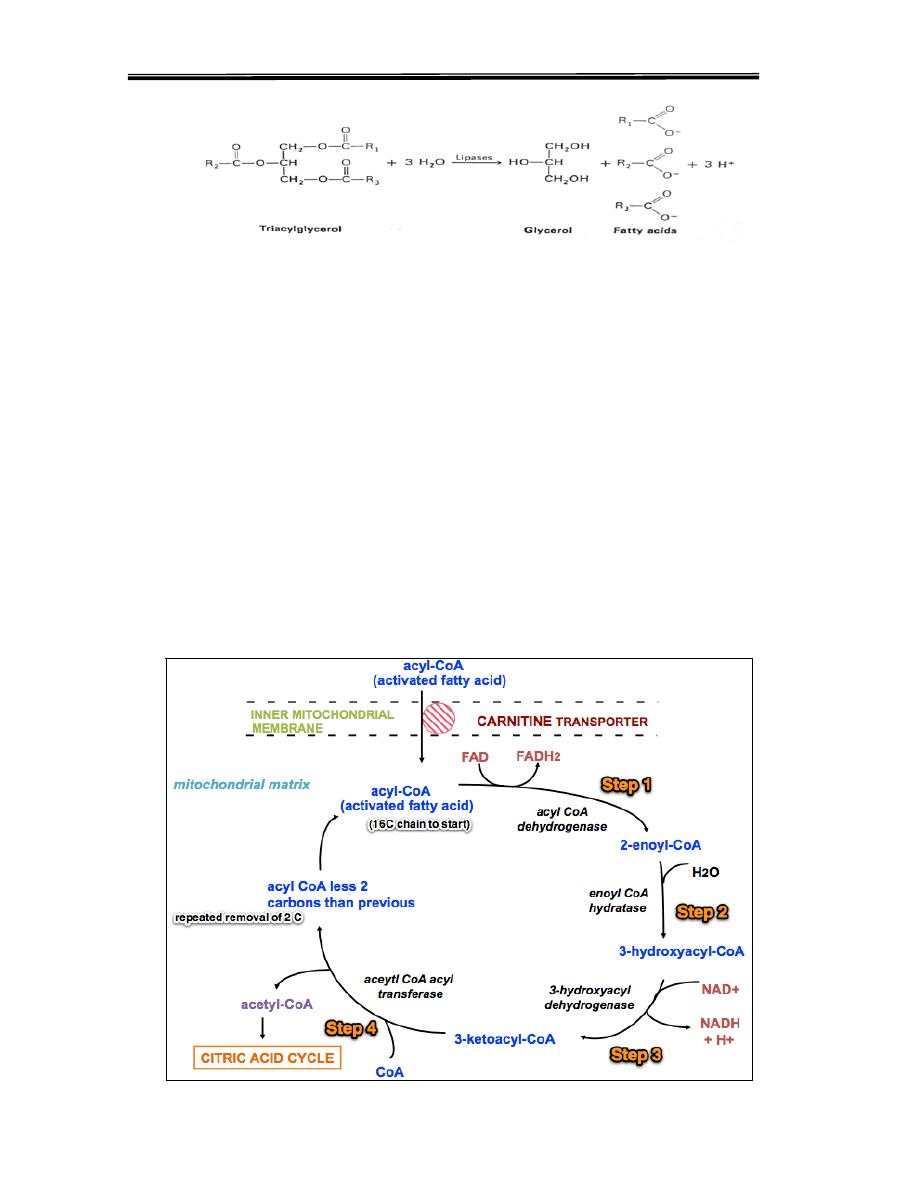
Clinical biochemistry second stage
2
Then free fatty acids move through the cell membrane of the adipocyte,
and immediately bind to albumin in the plasma. They are transported to
the tissues, where the fatty acids enter cells, get activated to their CoA
derivatives, and are oxidized for energy.
Fatty acids are both oxidized to acetyl-CoA and synthesized from acetyl-
CoA. Although the staring material of one process is identical to the
product of the other, fatty acid oxidation is not the simple reverse of fatty
acid biosynthesis. It is an entirely different process taking place in
separate compartment of the cell. This allows each process to be
individually controlled.
Stages of fatty acid oxidation
(1) Activation of fatty acids
(2) Transport into the mitochondria
(3) Degradation (B-oxidation pathway)
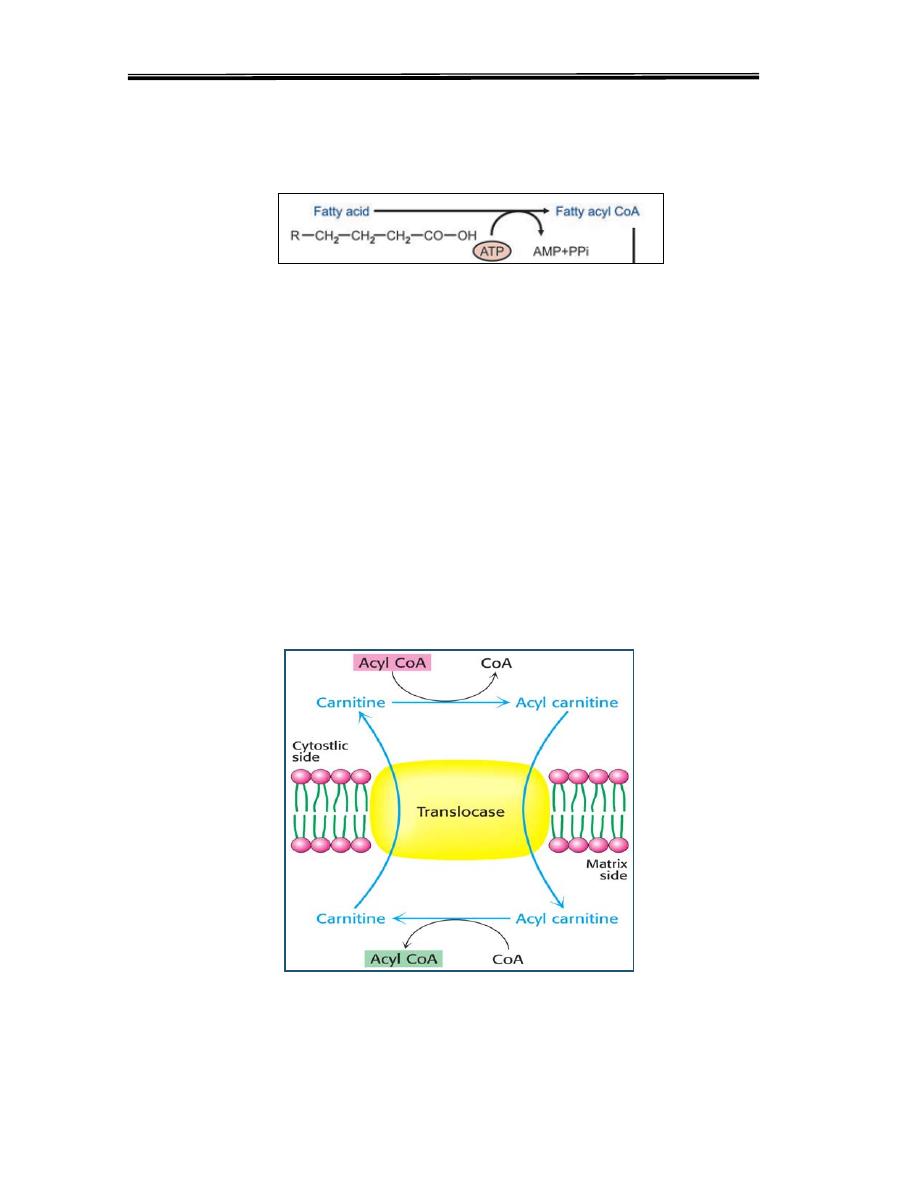
Clinical biochemistry second stage
3
Activation of Fatty Acids
Fatty acids are converted to CoA thioesters by acyl-CoA synthetase (two
ATP equivalents) are consumed to activate one fatty acid to a thioester.
Transport of Fatty Acyl CoA into Mitochondria
Fatty acids are activated in the cytoplasm; but the beta oxidation is in
mitochondria. So transport of fatty acids through the mitochondrial
membrane is essential. The long chain fatty acyl CoA cannot pass
through the inner mitochondrial membrane. Therefore a transporter,
carnitine is involved in transfer of fatty acids
The enzyme carnitine acyl transferase-I (CAT-I) will transfer the fatty
acyl group to the hydroxyl group of carnitine to form acyl carnitine .
translocase will carry the acyl carnitine across the membrane to the
matrix of mitochondria.On the matrix side of the membrane another
enzyme, carnitine acyl transferase-II (CAT-II) will transfer the acyl group
back to co-enzyme A molecule. Carnitine is returned to the cytosolic side
by the translocase.
Fatty acids shorter than twelve carbons can cross the inner mitochondrial
membrane without the aid of carnitine
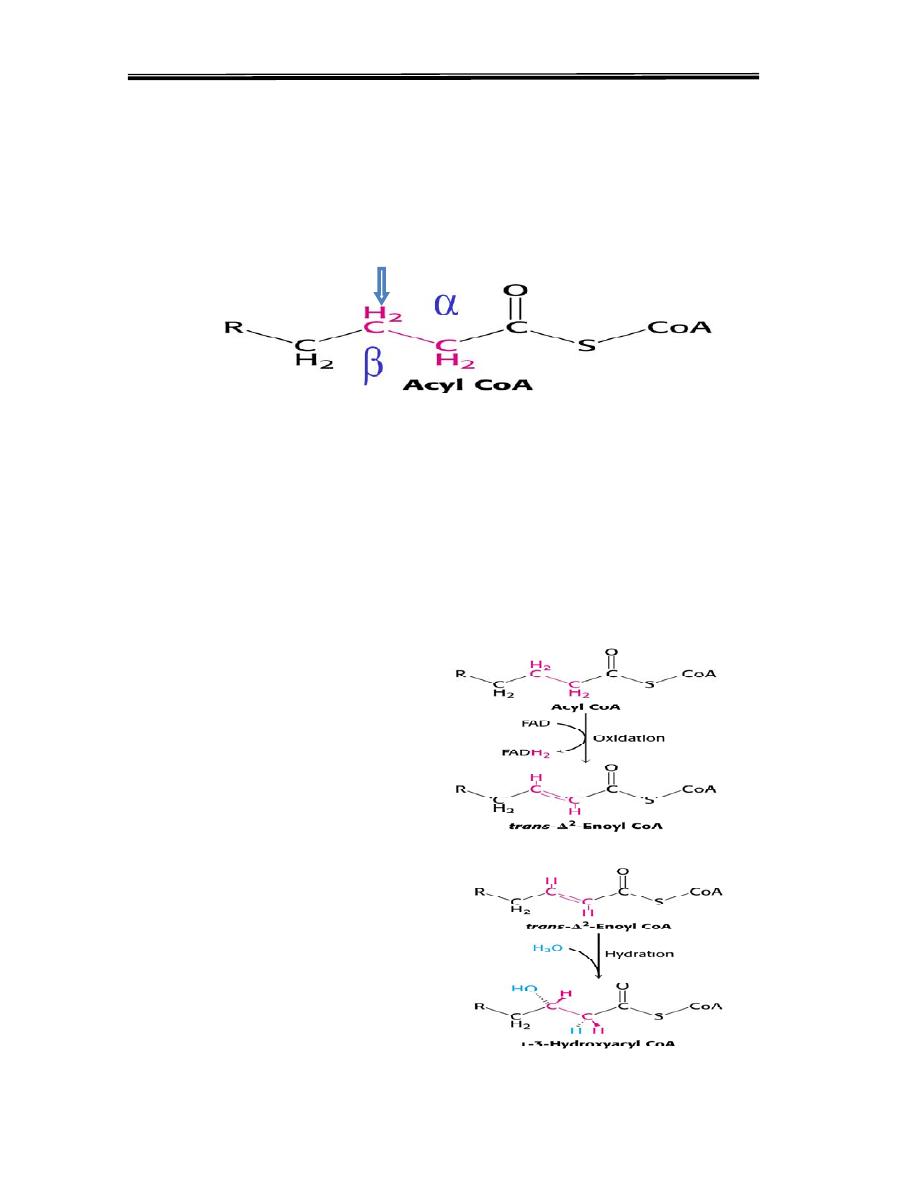
Clinical biochemistry second stage
4
The Reactions of B oxidation
The oxidation of the hydrocarbon chain (fatty acyl) occurs by a sequential
cleavage of two carbon atoms (as acetyl CoA) in the mitochondrial
matrix.
This process is known as beta oxidation, because the oxidation
and splitting of two carbon units occur at the beta-carbon atom
β-oxidation is consists of a sequence of four reactions that result in
shortening the fatty acid chain by two carbons. The steps include an
oxidation that produces FADH
2
,a hydration step, a second oxidation that
produces NADH, and a thiolytic cleavage that releases a molecule of
acetyl CoA. These four steps are repeated for saturated fatty acids of
even-numbered carbon chains (n/2)-1times (where n is the number of
carbons), each cycle producing an acetyl group plus one NADH and one
FADH
2
.The final thiolytic cleavage produces two acetyl groups.
1. Oxidation
of
acyl
CoA
by an
acyl CoA
dehydrogenase
to
give an
enoyl CoA
Coenzyme -
FAD
2. Hydration
of the
double bond between
C-2 and C-3 by
enoyl
CoA hydratase
with
the
3-hydroxyacyl
CoA (-hydroxyacyl
CoA)
formation
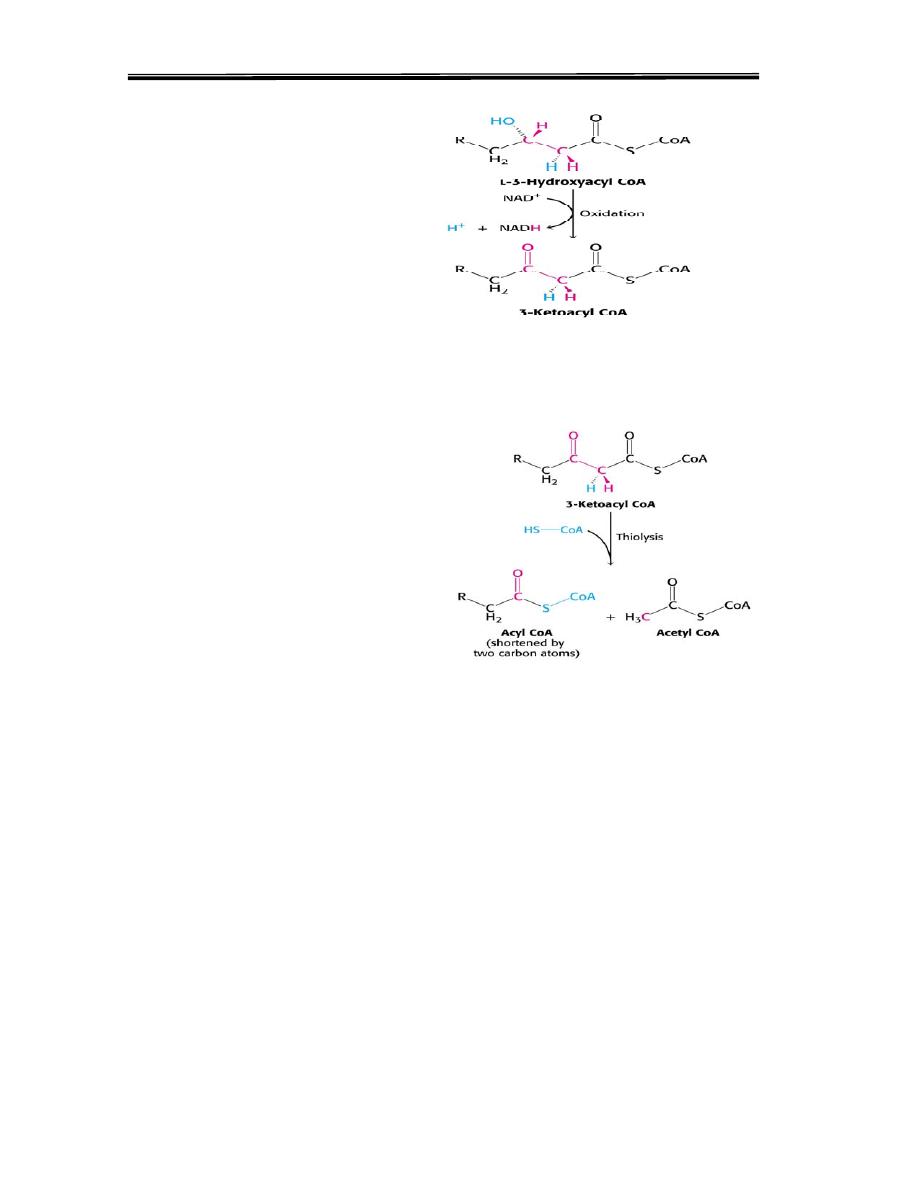
Clinical biochemistry second stage
5
3. Oxidation
of
3-hydroxyacyl CoA
to
3-ketoacyl CoA
by
3-hydroxyacyl CoA
dehydrogenase
Coenzyme –
NAD
+
4.
cleavage
reaction
catalyzed by
Thiolase
Each round (4 enzyme steps) generates one molecule of:
FADH2
NADH
Acetyl CoA
Fatty acyl CoA (2 carbons shorter each round)
Fates of the products of B-oxidation
NADH and FADH2 - are used in electron respiratory chain
acetyl CoA - enters the citric acid cycle
acyl CoA – undergoes the next cycle of oxidation
Energy yield from fatty acid oxidation
The energy yield from the β-oxidation pathway is high. For example, the
oxidation of amolecule of palmitoyl CoA(16 carbon) yields 129 ATPs
8 acetyl CoA
8x12=96
7 FADH
2
7x2=14
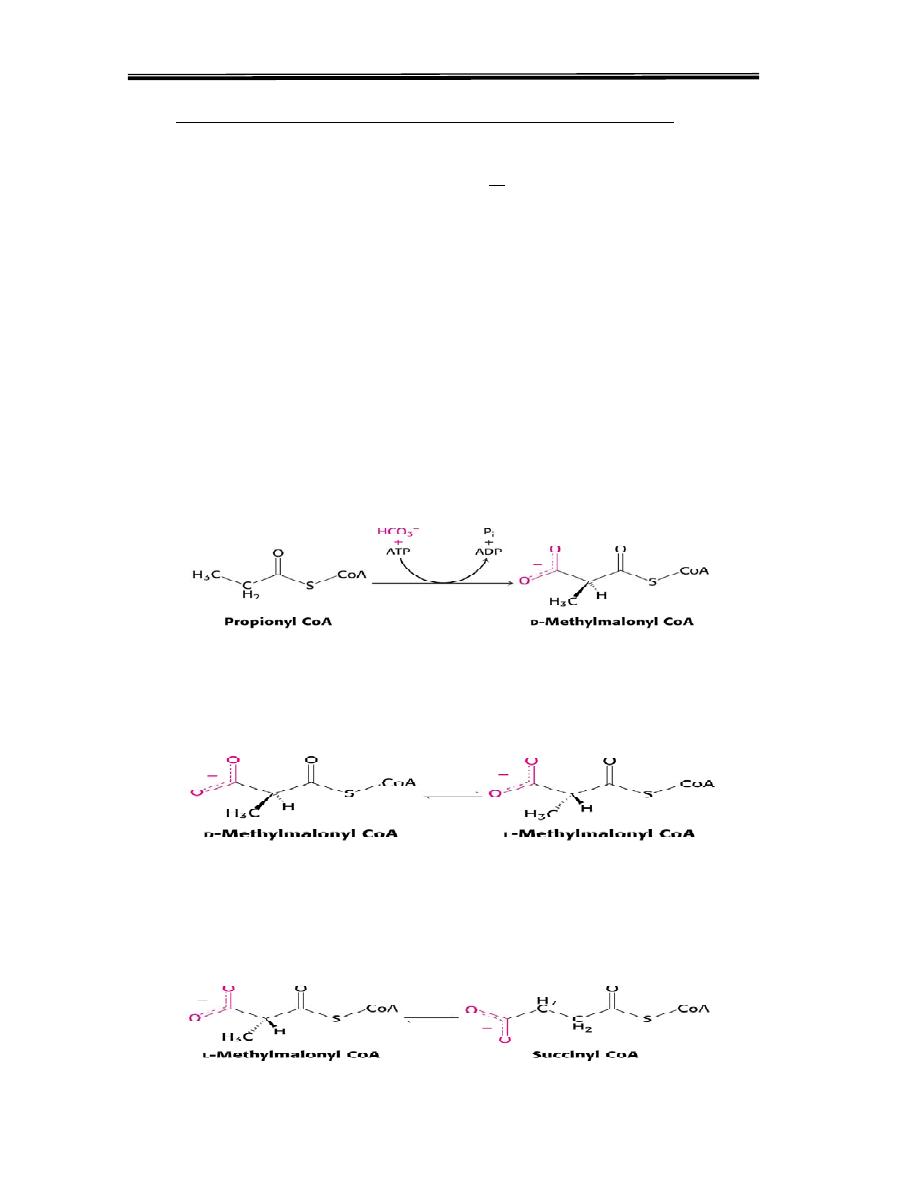
Clinical biochemistry second stage
6
7 NADH
7x3=21
131 ATP
ATP expended to activate palmitate -2
Net yield:
129 ATP
Oxidation of fatty acids with an odd number of carbons:
The β-oxi-dation of a saturated fatty acid with an odd number of carbon
atoms proceeds by the same reaction steps as that of fatty acids with an
even number, until the final three carbons are reached. This compound,
propionyl CoA, is metabolized by a three-step pathway
Propionyl CoA Is Converted into Succinyl CoA
1. Propionyl CoA
is
carboxylated
to yield the D
isomer of
methylmalonyl CoA
.
The hydrolysis of an
ATP is required
.
Enzyme:
propionyl CoA carboxylase
Coenzyme:
biotin
2.
The
D isomer
of methylmalonyl CoA is
racemized to the
L isomer
Enzyme:
methylmalonyl-CoA racemase
3.
L isomer of
methylmalonyl CoA
is converted
into
succinyl
CoA
by an intramolecular
rearrangement
Enzyme:
methylmalonyl CoA mutase
Coenzyme:
vitamin B
12
(cobalamin)
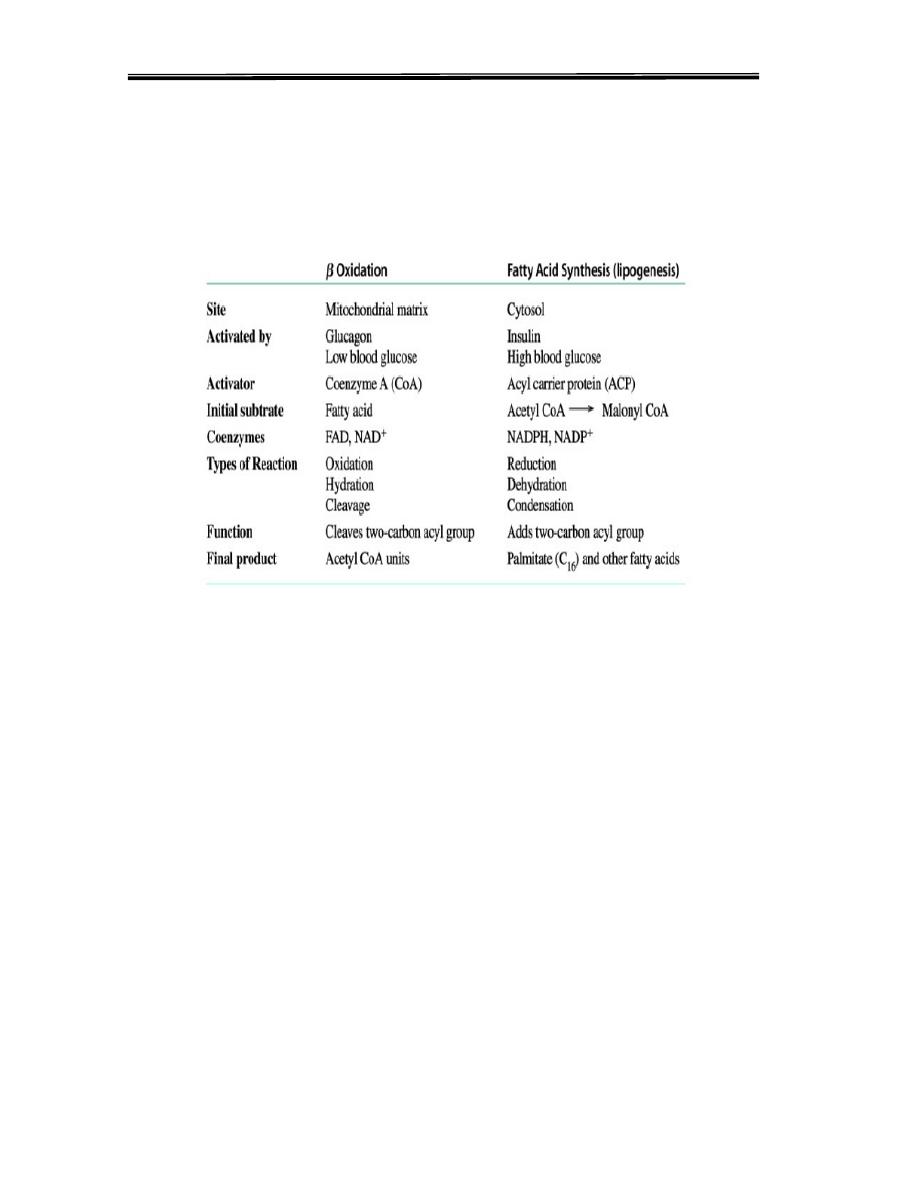
Clinical biochemistry second stage
7
β Oxidation of Unsaturated Fatty Acids
The oxidation of unsaturated fatty acids provides less energy than that of
saturated fatty acids because they are less highly reduced and, therefore,
fewer reducing equivalents can be produced from this oxidation.
Comparism between synthesis and degradation of fatty acids
Ketone Bodies Are Fuel That Are Synthesized in the liver
Unbalanced metabolism of fats and carbohydrate changes the flow of
nutrients pathways
Common factors in abnormal metabolic conditions
Lack of carbohydrates
Impaired use of carbohydrates
Fasting
Starvation
Untreated diabetes
Response to a Fast and Starvation
The natural response to glucose and energy deficiency is involves two
metabolic processes. Firstly the adrenal cortex secretes glucocorticoids to
stimulate gluconeogenesis.
Secondly growth hormone is secreted to accelerate lipolysis in adipose
tissue to provide fatty acids for oxidation.
Liver glycogen stores are depleted .Fatty acids can be used by heart,
kidney skeletal muscle and liver. Fatty acids are not used as fuel by the
brain because they do not cross the blood brain barrier. Survival during
starvation is mainly determined by the size of the stored triacylglycerol
pool .After several days of starvation acetyl CoA is made in abnormally
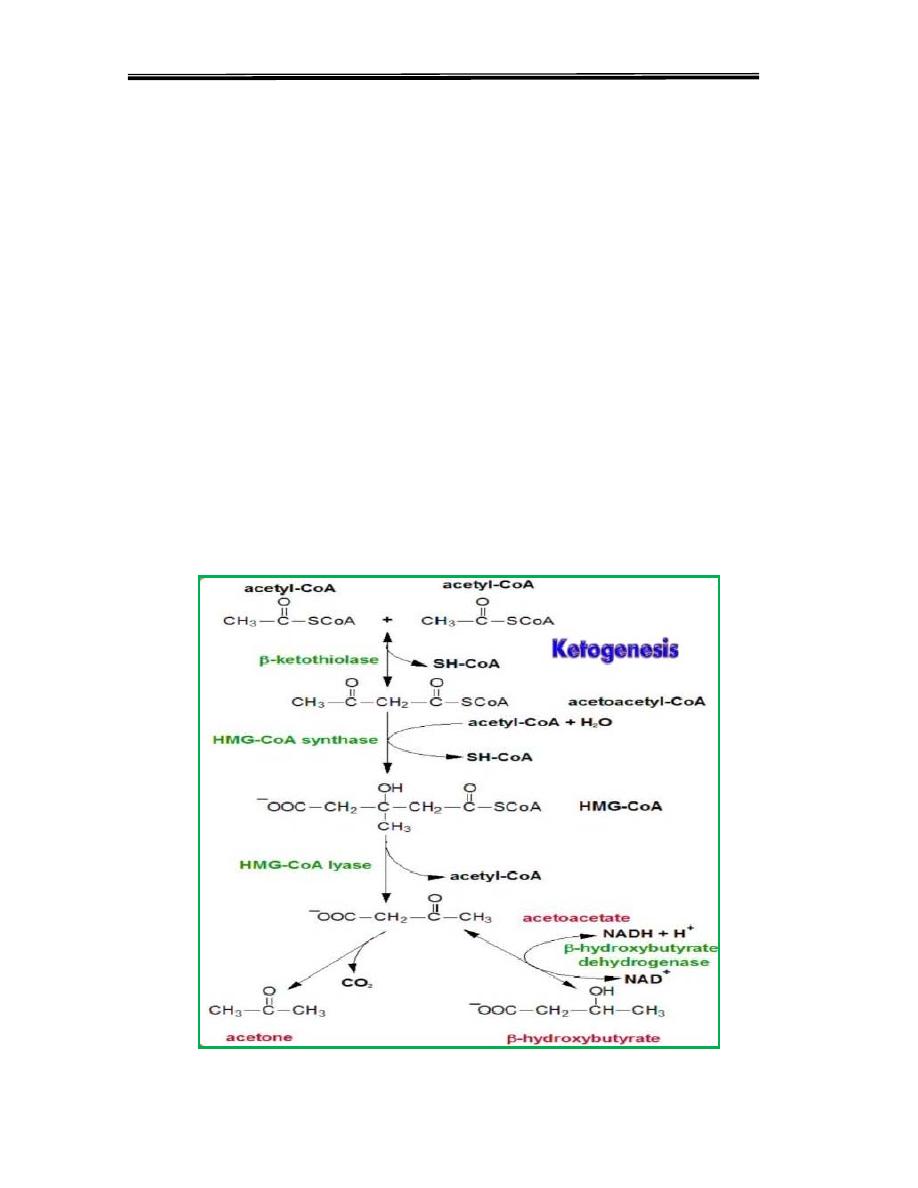
Clinical biochemistry second stage
8
high amounts due to excessive fatty acid breakdown since
glucose/glycogen is not available, glucose is the primary source of fuel
for the human brain therefore the rate of gluconeogenesis has to increase
during fasting or carbohydrate starvation, oxaloacetate in liver is depleted
from the TCA cycle because it is used for gluconeogenesis(making
glucose for the brain) impedes entry of acetyl CoA into the TCA cycle.
Excessive Acetyl CoA is converted in liver mitochondria to ketone
bodies.Ketone bodies can be thought of as “soluble fats exported to cells
that need it.
Synthesis of the ketone bodies
1. β Ketothiolase condensing 2 acetyl CoA to produce acetoacetyl CoA,
with release of one CoA
2. HMG CoA Synthase catalyzes condensation of a third acetate moiety
(from acetyl CoA) with acetoacetyl CoA to form hydroxymethylglutaryl
CoA (HMG CoA).
3. HMG CoA Lyase cleaves HMG CoA to yield acetoacetate plus acetyl
CoA
4. β Hydroxybutyrate dehydrogenase catalyzes inter conversion of the
ketone bodies acetoacetate and β hydroxybutyrate.
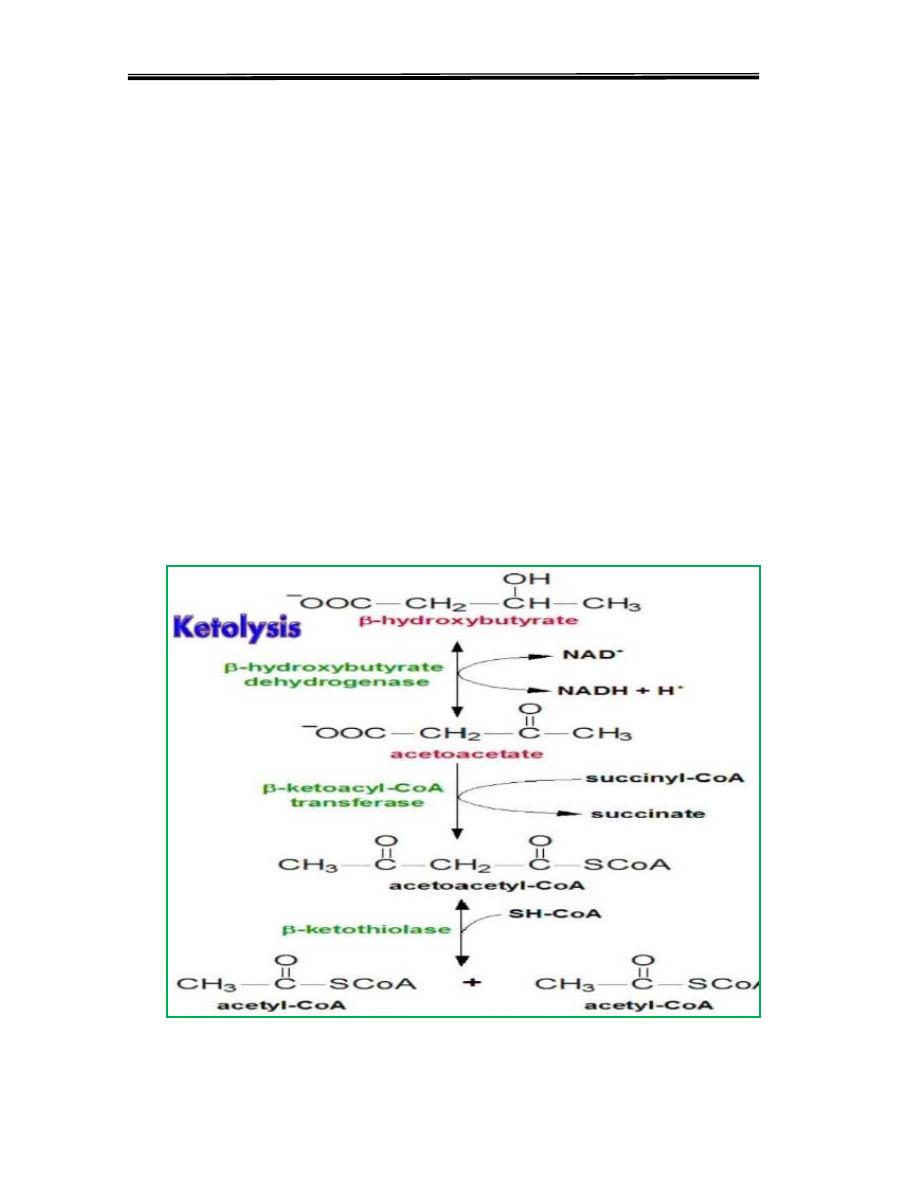
Clinical biochemistry second stage
9
Ketone Bodies are oxidized in mitochondria of many tissues other than
liver .Liver cannot use ketone bodies because the activating enzyme
required for ketone body utilization is absent in the liver.
While ketogenesis is an important survival mechanism that maintains
high rates of fatty acid oxidation when carbohydrates stores are depleted,
it can also lead to pathological conditions if acetoacetate and D-β-
hydroxybutyrate levels in the blood get too high. Acidosis is a condition
referring to low blood pH which can occur when ketogenesis produces
more acetoacetate and D-β- hydroxybutyrate than what can be utilized by
the peripheral tissues. In patients with undiagnosed diabetes, which is a
metabolic form of carbohydrate"starvation," elevated concentrations of
acetoacetate and D-β-hydroxybutyrate in the blood and urine can be
several orders of magnitude higher than normal causing nausea, vomiting
and stomach pain. Moreover, these individuals also have high levels of
acetone in their blood which can be detected on their breath as a fruity
odor. Acetone is a spontaneous breakdown product of acetoacetate
